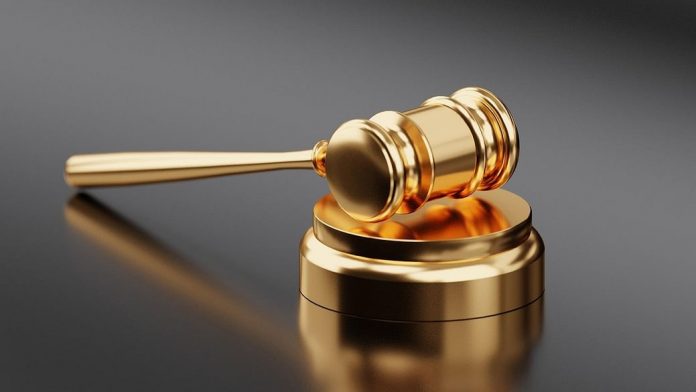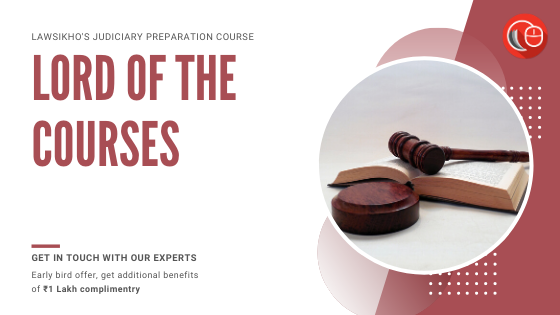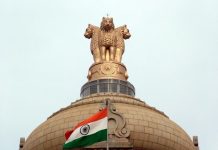In this blog post, Priyamvada Singh, pursuing LLB(H) from School of Law, Galgotias University, talks about the Indian courts, their hierarchy, and the judicial system of India. A comprehensive analysis of the state of Indian judiciary has been made.
Table of Contents
Introduction
Roughly three years after India gained independence from the British colonial rule, on the historic day of 26th January 1950, the Constitution of India was brought into force in the country. The world watched as the largest Constitution of the world was ambitiously applied to the biggest democracy of the world. The world gazed amazedly at the success of this political experiment. It was rather questionable as over 550 princely states came together for an unprecedented social, political, and economic revolution. This was unprecedented in a country with a history of being broken on the lines of caste, gender, and religious biases.
However, at the behest of the unique ability of its lawmakers, leaders, and administrators, the experiment came to life with all its colours. Forums like the Supreme Court and the other kinds, viz- the High Courts and its Subordinate Courts, an infrastructure to address the large population’s issues were established. The aim of the setting up of this infrastructure was to gain and maintain law and order over the large masses. This was to be done by commanding respect and being blind in the face of status. This led to a range of social revolutions that were once deemed impossible.
The Indian administration rests on its three integral pillars, viz:
- Legislature,
- Executive, and
- Judiciary.
They all function on the doctrine of Separation of Power. This means that each of these organs stands independent from another, and can function separately, and any of these organs of the government must not interfere with the other.
India has been experiencing an influx of dockets in recent decades, and there is a huge problem of massive case arrears. Today, there are more than 3.5 crore cases pending in various courts across the nation. This has effectively hampered the optimal working of the organ and has adversely affected the timely delivery of justice, according to the Supreme Court Report on Access to Justice (2016). Further aggravation of the crisis is done due to the asynchronous perceptions of the solution of the problem, between the government and the courts.
The Judicial System of India stands to be one of the oldest legal systems in the world today. It is a by-product of the 200-year-old colonial rule of the British in India. After they left, an expandable framework was given by the Indian Constitution and bestowed the judicial system the powers it possesses today. There is a hierarchical model of the judiciary in India—different types of courts, each with varying powers depending on the tier and jurisdiction bestowed upon them. The hierarchy of courts in India follows a pyramidal model, with the Apex Court resting at the top, followed by High Courts of respective states with District Judges sitting in District Courts and other courts at the bottom.
Supreme Court
As per the Constitution of India, the Supreme Court is the final court of appeal. Its first sitting was on the 28th day of January 1950. Part V of Chapter IV of the Constitution of India provides for the establishment and working of the Supreme Court. It provides for separate high courts for separate states but according to the 7th Constitutional Amendment Act the same high court can be the court for more than one state. At present, we have 21 high courts in the country, which includes 3 common high courts. It is to be an Appellate Court and as a safe-keeper of the Constitution. The jurisdiction of the same is provided for from Article 124 to Article 147. Along with admitting cases of appeal, it also takes up Special Leave Petitions and Writ Petitions. SLPs are taken in if the court feels there has been a gross miscarriage of justice. Writ Petitions are accepted in cases of human rights violations, amongst others.
Constitution
Article 124 of the Constitution provides for the establishment and the constitution for the Apex Court.
- It asserts that the aforementioned established court shall have a Chief Justice, and seven other judges unless a higher number is prescribed later.
- Each of these judges shall be appointed by the President of India, and shall retain his position until he attains sixty-five years of age.
- The minimum age for qualification is decided as per the present laws of the nation. This means that whenever the question of the minimum required age of the judges is to be decided, the current condition and times of the country shall have to be taken into account.
To ensure that the Supreme Court remains untainted at the hands of the other organs so that the constant tussle amongst the three organs results in a balanced democracy, the Supreme Court is made to be an autonomous body. This means that starting from the mode of appointment of its staff to their tenure, to the forum’s contempt and its repercussions, till the forbidding of the judges from pleading in any court after their retirement, everything is decided upon, and fixed by the forum itself.
The need for autonomy of the Supreme Court recently ended up in a big controversy of NJAC v. Collegium debate. In this controversy, the 99th Amendment passed the NJAC Bill, which allowed for the executive to have a say in the appointment of Judges to the Supreme Court. It was declared unconstitutional by the Apex Court.
Powers
Several distinct powers have been conferred upon the Apex Court by the Constitution. Some of these are listed down under, viz:
- Court of Record:
If evidence has been presented related to a case in the Apex Court, and the latter accepts it- there shall be no further questions about its evidentiary value. Evidentiary value is the value of those records which are necessary to provide authentic and adequate evidence of an organization’s actions, functioning, policies, and/or structure. Evidential value relates to the document’s creation and not necessarily to its content or information about the activities, functions, and origins of its creator.
- Power to Punish:
If a person, group, or institution is found to be engaging in the Contempt of Court (CoC), up to 6 months of incarceration, or fine of up to Rs. 2,000/-month, or both, may be awarded to them, as per the CoC Act, 1971. It is important to note that there are two types of Contempts, namely:
- Civil contempt: which refers to the willful disobedience of any judgment passed by the Court.
- Criminal contempt: which refers to an act of lowering the authority of the Court, harming its decorum, or interfering in its proceeding(s).
- Guardian of the Law:
The Apex Court has the power to examine and declare whether the laws passed by the Legislative organ or the actions of the Executive are as per the Constitution. In the case of State of Uttar Pradesh v. Raj Narain,1975, the Supreme Court had even declared that the then Prime Minister of India, Mrs Indira Gandhi, was guilty of engaging in electoral malpractices and further forbade her to hold offices for more than half a decade. Justice Jagmohanlal Sinha was widely applauded and equally criticised for this judgement.
- Rule Maker:
Although this is a topic of great debate amongst jurists. Based on the principle of Obiter Dicta, and Precedents, the SC enjoys an indirect, rather soft, power to make rules. It is allowed to pass landmark judgements that might fall outside the laws already formed. However, this is a power exercised exceptionally so as to not disbalance the status quo.
- Article 139A – Withdrawal of cases pending before high courts and disposing of them itself.
- Article 127 comes into the picture in case there is a lack of strength of judges in the Supreme Court. The Article suggests that the sitting Chief Justice may appoint a judge on ad hoc basis, however, he shall require the consent of the current President, along with the consent of the Chief Justice of the High Court in question, meaning from where the Judge has to be brought in. Another essential is that the ad hoc judge to be appointed should be qualified to become a judge of the Apex Court.
- Similar to the provision aforementioned, according to Article 126 – if the office of the CJI (Chief Justice of India) is empty, or that he is unable to discharge his duties, a Judge of the Apex Court may be appointed to hold office, at the consent of the President.
- Article 128– The CJI at any time with the previous consent of the President and the person to be so appointed can appoint any person who had previously held the office of a Judge of SC.
- Article 137 provides the Apex Court with the power to enquire and look into any order passed by the same, in order to do away with discrepancies or errors made by the judge in the passing of the judgement. This is done to maintain the integrity of the Court, and also to do away with absolutism on the part of the judiciary, enabling checks and balance.
- The Supreme Court can even look into the workings of the Union Public Service Commission, and if the need is, recommend the removal of its members to the President of the country since only the latter has the power to do so.
Jurisdiction of the Supreme Court
Jurisdiction is defined as the power bestowed upon a court to pass judgements or orders in the instant cases brought to it. Meaning thereby, that each court is empowered with some official ability to take in, and sustain cases in its forum. The jurisdictions bestowed upon the Supreme Court is of three distinct kinds, namely:
- Original
- Appellate
- Advisory
They are defined as follows:
- Original jurisdiction:
Article 131 provides the Court with original jurisdiction of the Supreme Court. This means that no other Court, except the SC, may address cases being contested between the Government of India and its States; or between two or more States.
- Appellate Jurisdiction:
Article 132 provides the Apex Court with Appellate Jurisdiction. This means that the SC can overturn, or sustain, based on the merits of the case, any order or judgement passed by any High Court in proceedings: both civil or criminal in nature. In other words, an appeal lies in the Supreme Court as regards to any judgement passed by a High Court within the territory of India. However, this is a discretionary power.
Article 136 asserts for the provision of Special Leave Petitions(SLPs), wherein if the SC observes the possibility of a gross miscarriage of justice at the hands of any court or tribunal of India, including the laws related to the armed forces, it shall have the power to overturn or sustain, said order or judgement. This, too, is a discretionary power and not a right of the appellant.
Article 137 provides that the Supreme Court has the power to review any law and rules made by the legislation as to the workings of the SC, including appeals, bails, and procedural laws, etc. of the Apex Court formed under Article 145.
Article 141 provides for the Supreme Court to be the final forum of appeal, whose judgements shall be binding on all other courts within the territory of the nation.
Appointment of judges
For a person to be appointed as a Judge of the Supreme Court, he shall mandatorily have to be:
- A citizen of India, and,
- A judge in a High Court, or in two High Courts consecutively, for a minimum tenure of five years, or
- An advocate in a High Court, or in two courts consecutively, for a minimum duration for ten years, or
- The President must consider him an eminent jurist.
The provision for the oath of the Judges has been provided for in Article 124(6) of the Constitution, viz: The form set out for the same is mentioned in the Third Schedule of the Constitution. Additionally, the oaths are administered to the Judges by the Chief Justice of India, and to the CJI, the President administers the oath.
Article 124(7) puts restrictions on these Judges. It says that once a person holds office as a Judge of the Apex Court, he is forbidden to plead in any court in India, regardless of the authority of the forum. This is done to prevent an accumulation of power, along with maintaining the decorum and position of the Court.
The Chief Justice is to be consulted by the President of India prior to the appointment of any judge, except for one of his own positions, i.e. the CJI.
Further, if any of these judges shall resign, they shall address the then President of the country, as per Article 124(4). The provision of impeachment, meaning the removal of a judge owing to incapacity or misbehaviour, is provided for in Article 124(4)(5). It says that such a move may only materialise itself if it is supported by at least two-third majority of the houses of the parliament. The parliament shall be the judge on the inconsistencies and its allegations too. There have been zero cases of impeachment of a Supreme Court judge in India till date, however, there has been a myriad of cases wherein judges have faced such motions. Justice V. Ramaswami was the first judge to face impeachment charges in independent India, although it never materialised.
Transfer of certain cases
Section 406 of the Code of Criminal Procedure,1860 says that if the Supreme Court feels that it is necessary for the carrying out of justice, then at the application of the Attorney-General, or of the party involved, a case may be transferred from the High Court of one state to another. It is important to note that it shall only be done if the Court feels there is a probability of miscarriage of justice. This power is enabled in the spirit of Justice, Equity, and Good Conscience.
Provided that the Supreme Court may, after determining the said questions of law, return any case so withdrawn together with a copy of its judgment on such questions to the High Court from which the case has been withdrawn, and the High Court shall on receipt thereof, proceed to dispose of the case in conformity with such judgment.
Powers of President to consult the Supreme Court
- Advisory Jurisdiction:
Article 143 provides the SC with Advisory Jurisdiction. It claims that in case the need for interpretation of laws arises, at the hands of the President, especially if the need of the interpretation will prove to be of public value, the President shall consult the Apex Court for its opinion.
High Court
Under Article 214 of the Constitution of India, every state should mandatorily hold one High Court. It is the final court of appeal in the State as regards to any case, the only one appeal left post that is at the hands of the Apex Court. There are a total of 25 High Courts, their seats being placed in the capital of their respective states. However, the constitution even provides for common High Courts between two or more states, in Article 231. Some of these High Courts are the Bombay HC, Calcutta HC, Gauhati HC, and the J&K HC. These courts have jurisdiction over a group of states or Union Territories.
The first High Court in India was set up in 1862 in Calcutta. The newest High Court is the one established in Andhra Pradesh in 2019.
Jurisdiction of High Court(s)
As aforementioned, Jurisdiction is defined as the power bestowed upon a court to pass judgements or orders in the instant cases brought to it. There are multiple jurisdictions provided to each High Court of India, some of which are mentioned below.
- Original Jurisdiction
- Civil Jurisdiction: High Courts hold the jurisdiction to hear cases which are civil in nature, and hold worth up to Rs. 2,00,000.
- Criminal Jurisdiction: The High Courts can try all criminal offences of the state, including those punishable with death.
- Writ Jurisdiction: The High Court has the power to issue writs, in case it feels gross miscarriage of human justice has taken place.
- Election Jurisdiction: The high Courts can admit cases pertaining to the election(s) held, or being held, in the respective state(s).
- Appellate Jurisdiction
- Civil Cases: The High Court holds an appellate jurisdiction against a district court’s judgement.
- Criminal Cases: The High Court holds appellate jurisdiction over judgements, orders, or decrees, passed by the District Courts, Sessions Courts(if the judgement provides the appellant with an incarceration period of 7 years or more), and even Additional Sessions Court(If capital punishment has been awarded). If the sessions judge has awarded imprisonment for 7 years or more.
- Constitution Jurisdiction: In case of any question arising out of the interpretation of the constitution, the High Court shall have the final say, the appeal of which shall lie with the Apex Court.
Constitution
There is no fixed number of judges in High Courts in India. It depends on the state in which the High Court is established. However, there mandatorily has to be the presence of the Chief Justice, who is appointed by the president.
Powers
Apart from the above, the High Courts hold powers which are described below.
As a Court of Record
- Like the Supreme Court, the High Courts, too, are Court of Record. This means that the subordinate courts may not question the validity of evidence indicted as the same in a case by a High Court judge.
As a Guardian of Subordinate Courts
- The High Court controls many facets of its subordinate courts, as regards to its records, judgements, orders, decrees, etc.
As a Guardian of the Legislature
- If found to be ultra-vires to the constitution, the High Court may declare legislation to be unconstitutional.
Appointment of Judges
Article 217 of the Constitution provides for the procedure of the appointment of a High Court Judge at the hands of the President of India. He is solely responsible for the appointment of any judge in a High Court. For this, he may, or may not need to consult the Governor and the Chief Justice of the respective State, along with the Chief Justice of India. A lobby in the judiciary advocates for All India Judicial Service for the subordinate courts, for a better draw of talent.
A High Court Judge holds the office until he completes the age of 62 years, as opposed to the Apex Court, where it is 65 years. The salaries and allowances of them are decided by the parliament by law, from time to time. While the salary of these judges is sourced from the State’s funds, the Pensions of the same are provided from the funds of the Center.
Salary: The salary of the Chief Justice and other Judges of a High Court is capped at Rs. 2 lakh 50 thousand. However, a bill pending in the Rajya Sabha aims to increase that amount.
Removal: A Judge of the High Court can be removed from office if proven misbehaviour or incapacity comes to light. The procedure followed is akin to that of the impeachment of a Supreme Court Judge.
Transfer: In case of the transfer of a High Court Judge is to take place, it has to be done at the behest of the President of India after the latter consults the CJI of India, and CJ of the High Court of a state to-and-fro where the transfer has to materialise.
Training of the judges
National Judicial Academy
The responsibility of training the judges in various subjects has been entrusted to the National Judicial Academy. This independent registered society has been set up in Bhopal, Madhya Pradesh. The aforementioned is a training institute established for the judges of High Courts and for those judicial officers(JOs), who have been deputed to the SC and the HCs. However, this is not its sole task. The academy also provides training to the JOs who have been posted in the districts. Set up in 1993 by noted lawyer and civil servant, N.R. Menon, this institute works towards enhancing the efficiency and functioning of the judiciary. Presently, the director of the academy is Hon’ble Justice KN Saikia. The chairperson of the National Judicial Academy is the Chief Justice of India o that time.
Transfer of certain cases
Article 228 of the Constitution gives the right to a High Court to transfer cases upon itself from its subordinate courts. Exercising the pyramidal form of a hierarchy of the judiciary, the High Court enjoys the power to bring upon itself any case from its subordinate courts(viz, district courts etc) that it feels involves the issue of the interpretation of the constitution.
This power arises from the function of the HC to be the interpreter of the Constitution where a substantial question as to the law arises. According to this Article, the court may dispose of the case after transfer if the need is, or, alternatively, it may decide the answer to the issue involved, get it on paper in a form of its judgement and return the case back to its respective court. Post that, the subordinate court shall take the judgement as the holy grail, and dispose of the case itself.
Conclusion
From the banning of bigamy in its first phase to the recent quashing of the practice of menstrual discrimination in the Indian Young Lawyers Association & Ors. vs. The State of Kerala & Ors. (2018) (The Sabarimala Case), wherein the entry of women from 10 to 50 years of age was banned in the Sabarimala Temple of Kerela, to the recent decriminalisation of Homosexuality in 2018, stated under Section 377 of the Indian Penal Code in the case of Navtej Singh Johar v. Union of India.
Apart from these, Indian Judiciary has also taken reforms that sought to instil transparency in Indian judicial system. This includes efforts like live streaming of Courts and bringing of CJI under Right To Information. With the recent statement by Justice Arun Mishra, who happens to be one of the senior-most judges of the Apex Court, praising the Prime Minister of the country, the world watched agape as the independence of the judiciary was brought into a questionable light. This is against the very basic element of the doctrine of separation of power, which dictates that all three pillars of the government work independently.
Certainly, the time is ripe for the Indian Judiciary to make more attempts and strike a balance between transparency & accountability. It is imperative to maintain the independence of the Judiciary. The deadline for this to be addressed has long passed, these deep systemic flaws need to be done away with before the system crashes to the ground. A nation as large as India certainly can not afford that.
References
- https://thewire.in/law/pending-court-cases
- https://en.wikipedia.org/wiki/List_of_national_legal_systems
- https://en.wikipedia.org/wiki/National_Judicial_Appointments_Commission
- http://www.supremecourtcases.com/index2.php?option=com_content&itemid=1&do_pdf=1&id=20392
- https://www.thehindu.com/opinion/op-ed/reviewing-the-contempt-of-courts-act/article23606610.ece
- https://www.livemint.com/Opinion/Pov37591YVpvCBqhiypvaO/When-India-was-forced-to-grow-up.html
- https://www.outlookindia.com/magazine/story/dark-chapter-worse/294570
- https://www.gktoday.in/gk/separation-of-powers-in-constitution-of-india/
- https://www.thehindu.com/news/national/list-of-judges-who-faced-impeachment-proceedings/article18578156.ece
- https://www.prsindia.org/billtrack/high-court-and-supreme-court-judges-salaries-and-conditions-service-amendment-bill-2017
- https://theprint.in/judiciary/in-a-first-calcutta-hc-allows-live-streaming-of-hearing-on-youtube/364436/
- https://www.thehindu.com/opinion/editorial/open-all-the-same-on-cji-office-and-rti-act/article29975187.ece
- https://www.thehindu.com/news/national/modi-a-versatile-genius-who-thinks-globally-and-acts-locally-justice-arun-mishra/article30887665.ece
- https://thewire.in/law/can-judges-legislate-the-supreme-court-sets-the-record-straight
- THE CONSTITUTION (SEVENTH AMENDMENT) ACT, 1956 …legislative.gov.in › constitution-seventh-amendment-act…
- http://web.worldbank.org/WBSITE/EXTERNAL/COUNTRIES/SOUTHASIAEXT/EXTSAREGTOPPRISECDEV/0,,print:Y~isCURL:Y~contentMDK:20584873~menuPK:496677~pagePK:34004173~piPK:34003707~theSitePK:496671,00.html
- https://indiankanoon.org/doc/508426/
- https://www.thehindu.com/news/national/office-of-cji-is-public-authority-under-rti-rules-sc/article29961646.ece
LawSikho has created a telegram group for exchanging legal knowledge, referrals and various opportunities. You can click on this link and join:














